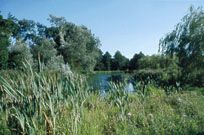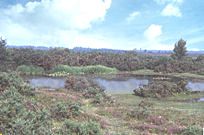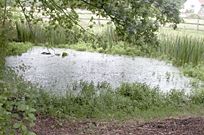Eutrophic standing waters in Britain.

Eutrophic waters are most typical of hard water areas of the lowlands of southern and eastern Britain, but they also occur in the north and west, especially near the coast.
In their natural state eutrophic waters have high biodiversity. Planktonic algae and zooplankton are abundant in the water column, submerged vegetation is diverse and numerous species of invertebrate and fish are present. In water bodies that are heavily enriched as a result of human activity, biodiversity is depressed because planktonic and filamentous algae (blanket-weed) increase rapidly at the expense of other aquatic organisms.
Lowland lakes and reservoirs containing hard water, tend to have a good range of mollusc species, provided the edges are not steep and emergent vegetaion can become established. Most invertebrates are to be found around the periphery of the lake.
Leisure pursuits such as boating, water sports and angling are all deleterious to invertebrate communities; the first two due to disturbance, and the third due to overstocking with fish in order to increase the catches.
Associated mollusc species include:
| Gastropods: | Bivalves: |
|---|---|
| Anisus vortex | Anodonta cygnea |
| Bithynia tentaculata | Dreissena polymorpha (mainly in reservoirs) |
| Gyraulus albus | Musculium lacustre |
| Gyraulus crista | Pisidium casertanum |
| Gyraulus laevis (as a pioneer coloniser) | Pisidium henslowanum |
| Hippeutis complanatus | Pisidium nitidum |
| Lymnaea stagnalis | Pisidium subtruncatum |
| Physa fontinalis | Sphaerium corneum |
| Planorbarius corneus | Unio pictorum |
| Planorbis carinatus | |
| Radix auricularia | |
| Radix balthica | |
| Valvata cristata | |
| Valvata piscinalis |
Oligotrophic and Dystrophic Lakes

Oligotrophic and dystrophic lakes are water bodies mainly more than 2 ha in size that are characterised by their low nutrient levels and low productivity. Their catchments usually occur on hard, acid rocks and contain water which is deficient in calcium.
Oligotrophic lakes usually have very clear water, whilst some examples with dystrophic characteristics have peat-stained waters.
Lakes of this type occur mainly in the north and west of Britain, and are generally poor in number of mollusc species. This arises not only from the fact that the water is low in calcium, but they are also colder than air temperatures might suggest. Water temperature depends a great deal on direct sunshine, which in mountains is reduced by cloud and fog, and corrie lakes facing north lose much of what sunshine there is.
Associated mollusc species include:
| Gastropods: | Bivalves: |
|---|---|
| Ancylus fluviatilis | Musculium lacustre |
| Anisus leucostoma | Pisidium casertanum |
| Bathyomphalus contortus | Pisidium conventus |
| Gyraulus albus | Pisidium hibernicum |
| Physa fontinalis | Pisidium lilljeborgii |
| Radix balthica | Pisidium nitidum |
| Valvata piscinalis | Pisidium pulchellum |
| Sphaerium corneum |
Ponds

Ponds are defined as permanent and seasonal standing water bodies up to 2 ha in extent; most are of the order of 350 sq. m. They may be subdivided into those through which a stream of water runs perennially or in winter, and which communicate with river systems ("running") and those without any direct communication with another watery habitat ("closed").
Ponds are widespread throughout the UK, but high-quality examples are now highly localised, especially in the lowlands. In certain areas high quality ponds form particularly significant elements of the landscape, e.g. Cheshire Plan marl pits, the New Forest ponds, pingos of East Anglia, mid-Wales mawn pools, the North East Wales pond landscape, the forest and moorland pools of Speyside, dune slack pools, the machair pools in the Western Isles of Scotland.
Those ponds which usually dry out in summer have their own community of molluscs, which is also dealt with below.
Mollusc species associated with "closed" ponds include: (Some of these species may also occur in "running" ponds, as will many of those normally found in lowland streams with which "running" ponds communicate)
| Gastropods: | Bivalves: |
|---|---|
| Acroloxus lacustris | Musculium lacustre |
| Anisus leucostoma | Pisidium casertanum |
| Bathyomphalus contortus | Pisidium milium |
| Bithynia tentaculata | Pisidium nitidum |
| Gyraulus albus | Pisidium obtusale |
| Gyraulus crista | Pisidium personatum |
| Hippeutis complanatus | Pisidium subtruncatum |
| Lymnaea fusca | Sphaerium corneum |
| Lymnaea stagnalis | |
| Physa fontinalis | |
| Planorbarius corneus | |
| Planorbis planorbis | |
| Radix balthica |

Species usually restricted to ponds which dry out in summer: (Some of these may also occur in other habitats of temporary water, such as ditches)
| Gastropods: | Bivalves: |
|---|---|
| Anisus leucostoma | Pisidium casertanum |
| Aplexa hypnorum | Pisidium personatum |
| Galba truncatula | Pisidium obtusale. |
| Lymnaea fusca | |
| Omphiscola glabra | |
| Planorbis planorbis | |
| Radix balthica |
